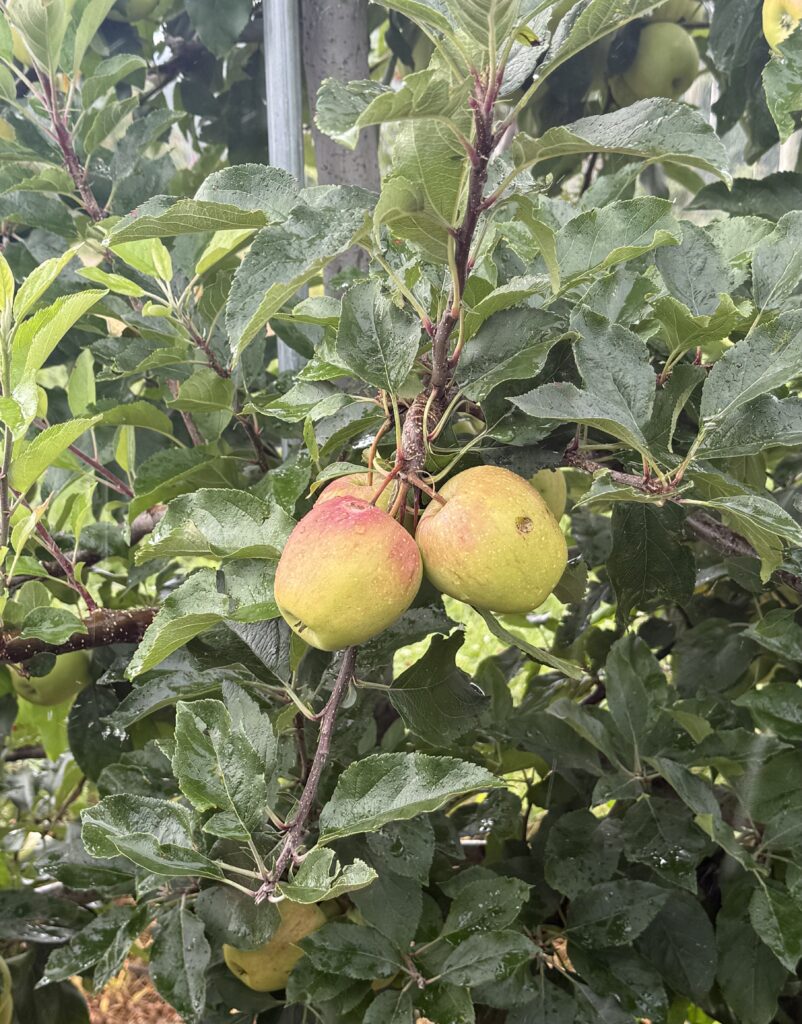Apple Disease Update: Week of July 6, 2025
go.ncsu.edu/readext?1081769
en Español / em Português
El inglés es el idioma de control de esta página. En la medida en que haya algún conflicto entre la traducción al inglés y la traducción, el inglés prevalece.
Al hacer clic en el enlace de traducción se activa un servicio de traducción gratuito para convertir la página al español. Al igual que con cualquier traducción por Internet, la conversión no es sensible al contexto y puede que no traduzca el texto en su significado original. NC State Extension no garantiza la exactitud del texto traducido. Por favor, tenga en cuenta que algunas aplicaciones y/o servicios pueden no funcionar como se espera cuando se traducen.
Português
Inglês é o idioma de controle desta página. Na medida que haja algum conflito entre o texto original em Inglês e a tradução, o Inglês prevalece.
Ao clicar no link de tradução, um serviço gratuito de tradução será ativado para converter a página para o Português. Como em qualquer tradução pela internet, a conversão não é sensivel ao contexto e pode não ocorrer a tradução para o significado orginal. O serviço de Extensão da Carolina do Norte (NC State Extension) não garante a exatidão do texto traduzido. Por favor, observe que algumas funções ou serviços podem não funcionar como esperado após a tradução.
English
English is the controlling language of this page. To the extent there is any conflict between the English text and the translation, English controls.
Clicking on the translation link activates a free translation service to convert the page to Spanish. As with any Internet translation, the conversion is not context-sensitive and may not translate the text to its original meaning. NC State Extension does not guarantee the accuracy of the translated text. Please note that some applications and/or services may not function as expected when translated.
Collapse ▲ It appears as though we’ve reached the afternoon rainy season here in western NC. While the rain directly aids in the disease infection process by bouncing conidia (asexual spores) to a new location, it’s the more indirect effects of extended leaf wetness periods that are particularly worrisome in regards, particularly in the case of Glomerella leaf spot. With temperatures often hovering in the mid-70s during afternoon rains in the Mountains, these extended leaf wetting events can lead to infection events by the Colletotrichum fungi causing Glomerella leaf spot and bitter rot.
It appears as though we’ve reached the afternoon rainy season here in western NC. While the rain directly aids in the disease infection process by bouncing conidia (asexual spores) to a new location, it’s the more indirect effects of extended leaf wetness periods that are particularly worrisome in regards, particularly in the case of Glomerella leaf spot. With temperatures often hovering in the mid-70s during afternoon rains in the Mountains, these extended leaf wetting events can lead to infection events by the Colletotrichum fungi causing Glomerella leaf spot and bitter rot.
That said, it may be worth including a single site fungicide in your tank with Captan 80WDG this week. If you don’t have resistance to strobilurins (FRAC 11), Merivon (5.5 floz/A), Luna Sensation (5.8 fl oz/A) or Flint Extra (2.9 fl oz/A) would be good options. However, I always prefer to save one strobilurin application (Merivon or Pristine) for the week prior to harvest as the activity of these fungicides last longer in storage. Therefore, if you’ve made two or fewer strobilurin applications this season, go with that. If you’ve already applied more than two strobilurin applications this year, or you have suspected or confirmed resistance to strobilurins (FRAC 11), consider Aprovia (7 fl oz) this week. However, please keep in mind that Aprovia has a 30 day PHI.
Since Ziram has been playing hard to get, I’ve been pondering a new alternative to captan for resistance management. Especially in late harvest cultivars where you may run out of your annual allowance of captan. Initially I was thinking that Omega could be a reasonable option in tank mixture with captan, but more recently given it’s decent efficacy in our GLS field trials and that it is a multi-site fungicide with a low resistance risk, I’m thinking Omega may be a reasonable alternative to Ziram, if you need to rotate away from captan for a spray. In our bitter rot and GLS field trials this year, Captan 80WDG applied weekly from bloom-today has so far provided the best control of GLS (97% control), whereas Omega applied weekly beginning at petal fall has provided 82% control. While not as efficacious as captan, Omega might have place when applied with a FRAC 11 (strobilurin) or Aprovia for resistance management. However, please keep in mind that Omega has a 28 day PHI.
Lastly, if you are concerned about strobilurin resistance in your particular Colletotrichum populations causing GLS and bitter rot, please get in touch with me, your consultants, or your extension agents. We are happy to screen for free (to you).


